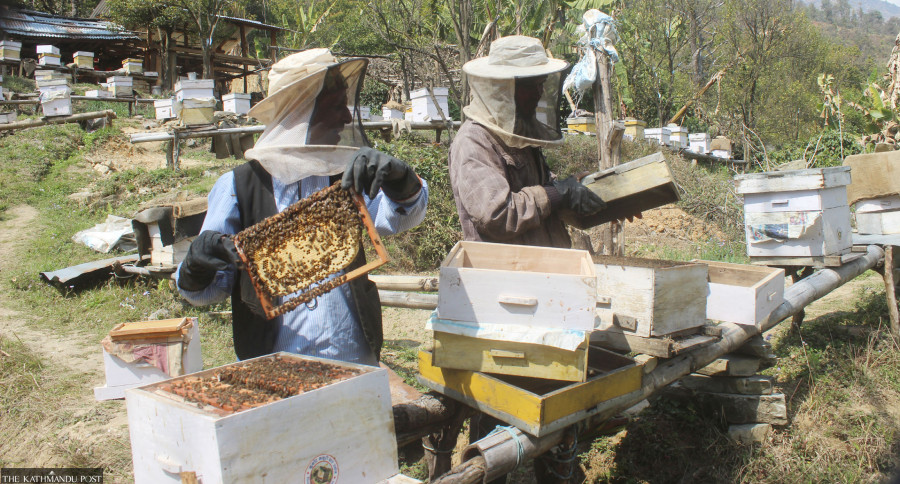Money
Winter brings bumper honey harvest in Nepal's mountains, but no markets
Beekeepers and government officials say despite the export potential, the influx of adulterated honey into the market is harming the reputation of the original organic product.
Mahesh KC
Om Prakash Khadka, a beekeeper in the mountainous region of northern Nepal experienced an unusual burst of optimism this winter—a rarity in his line of work.
The reason? A bumper honey harvest from his hundreds of hives.
But his joy was short-lived because he had no market to sell his prized organic honey.
"Only about 583 kg of honey has been sold so far. Around 466 kg remains unsold," said Khadka, who has been involved in apiculture for almost a decade.
Khadka had hoped that the bumper harvest would strengthen his revenue, but the absence of a market for his product has left him disappointed.
“There is not enough demand for honey, though the price exceeded Rs1,200 per kg this year,” he said. The low demand has been causing difficulties for many beekeepers like Khadka.
The honey harvest in the last two years was disappointing due to untimely rainfall that delayed the flower bloom, the key source of nectar for bees.
“Now, there is a bumper production, but there is no market,” said Khadka.
Khadka said that he would have earned Rs1.3 million had he been able to sell all the honey.
After two years of disappointing harvest, this year, beekeepers in Pokhara village in ward 3 of Sisne Rural Municipality were excited. Their hopes, however, dashed.
The small village in western Nepal has been declared a honey pocket area.
Commercial bee farming has thrived helping beekeepers to make handsome earnings from beekeeping.
In Pokhara village alone, a dozen farmers are involved in commercial beekeeping due to the abundance of Chiuri trees. The plant is commonly known as a butter tree and locally known as 'Chiuri' in Nepal.
Chiuri (Aesandra butyracea) flowers are extensively visited by honeybees and hence beekeeping is very popular in the area.
Studies show that sugar concentration in Chiuri nectar is recorded at up to 42 percent. As a rich source of nectar, coupled with a long blooming period, the Chiuri tree has a major role in honey production. In the hill areas, beekeepers can get 2 to 3 harvests of monofloral honey from Chiuri flowers.
Kamal Lal Khadka, another beekeeper, has been involved in beekeeping for a decade. This year, he is elated as he had never before seen such a good harvest.
"I've sold nearly 200 kg of honey so far. I still have more than 233 kg in stock,” he said. “We used to struggle to meet the market demand until last year," he said. But this year’s bumper harvest has worried everyone as they are unable to sell the honey.
In Nepal, honey production has consistently increased over the last few years.
In 2019-20, the national honey production was recorded at 3,997 tonnes, which then grew to 4,062 tonnes in 2020-21. It further grew to 5,168 tonnes in 2020-21, according to the statistics of the agriculture ministry.
It is estimated that, at present, there are about 249,680 beehives in Nepal, with the majority of them being Apis cerana hives.
Beekeeper Mahendra Malli, in Rukum East, who has produced 700 kg of honey this year, laments that there is no proper value of organic honey.
Beekeepers say that the lack of promotion of organic honey was the main reason behind the low demand.
“The availability of cheaper honey, produced by mixing sugar has flooded the market,” said Kamal Lal.
Beekeepers said the adulterated honey, mostly in the Tarai, is pushing their organic product out of the market. “It will be difficult to continue beekeeping if a similar situation continues,” said Kamalal.
Pitambar Neupane, the chief of the Integrated Agriculture and Livestock Development Office in Rukum East, said honey production in the district has been estimated at 12 tonnes this year.
Neupane said that villages like Syalapakha, Gothichaur, Panga, Dhaaka and Chunbang Rural Municipality have reported bumper harvests.
“As harvest has just started, there is no need to worry about sales,” said Neupane.
Nepal’s diverse climatic conditions and abundance of flora make it host to five species of honeybee.
Among these, only the Asian hive bee (Apis cerana) and the European honeybee (Apis mellifera) can be kept in hives and managed for honey production and pollination.
The other three species—the Himalayan cliff bee (Apis laboriosa), the giant honeybee (Apis dorsata) and the dwarf honeybee (Apis florea)—are wild.
Nepal is the only country in the world where honey is produced between the ranges of 70 meters to 4,200 meters above sea level.
Once honey export was a thriving business, but the European Union banned the import of Nepali honey in 2002 in its territory, stating the quality of Nepali honey was not as per the European standards.
It was found that Nepali honey had excessive pesticide residuals.
Before the ban, around 100 tonnes of honey used to be exported to the European market annually.
The export never recovered.
In the last fiscal year 2022-23, Nepal’s honey exports amounted to a meagre 5.4 tonnes worth Rs18.49 million, which is 0.1 percent of the country’s total production.
Neupane said that despite the export potential, the adulterated honey has been damaging the reputation of the organic product.




 14.12°C Kathmandu
14.12°C Kathmandu














